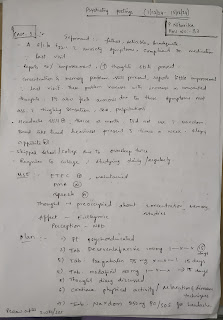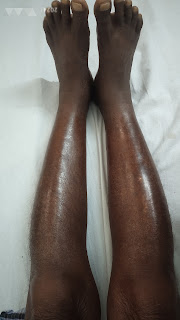MY JOURNEY AS AN INTERNEE IN MEDICINE DEPARTMENT
1)self- reflective writing on their medical student career:
Hello, I am NIHARIKA PENUKONDA, Internee 2k18 BATCH.
I am here to share my internship journey in medicine department.First of all I would like to express my gratitude to our HOD sir, faculty, and post-graduate sirs and madams who guided me at every step, enabling me to successfully complete my internship despite encountering numerous challenges.
In the begining of my journey in medicine posting i faced some difficulty while handling clinical duties and communicating with patients and attending rounds but later with the support of my pgs, faculty i learnt how to balance each and every aspect of medical care that we supposed to deliver to the patient and how to integrate with other departments. I got the opportunity to learn and see new cases while attending rounds.
My actual journey in medicine was commenced when i was in 5th semester. For the first time i was exposed to real patients in icu, wards and the concept of creating patient blogs and learnt how to take detailed history and correlate clinical findings and investigations and made me think of various causes of a particular condition and how to contribute my share as a helping hand in patient care and better outcome.
When i get started my postings my first case was a 40 yr old male who came with complaints of bilateral lower limb swelling since 20days. Generalized anasarca since 15days and Shortness of breath grade 3 and 4 since 10days. I took history and learnt about causes of his pedal edema and shortness of breath ,and pg s helped me in examining and understanding about the case and mechanism behind his pedal edema and sob and the patient was diagnosed with Pulmonary oedema secondary to acute left ventricle failure, anemia secondary to renal failure with HTN.
Here is the blog link:
https://niharikapenukonda122.blogspot.com/2022/01/a-40-yr-old-male-with-ckd.html
I started my journey as an internee in medicine department from 1/12/23 to 31/1/24.
1/12/23 - 15/12/23 : psychiatry
16/12/23 - 31/12/23 : Units
1/1/24 - 15/1/24 : Peripherals
16/1/24 - 31/1/24 : Units
Psychiatry:
Learning points:
Learnt detailed history taking and developing rapport with the patient to gain trust and maintaining confidentiality and helping patient to cope up with the condition and counselling and monitoring.
Cases that i saw during my posting in psychiatry:
ALCOHOL DEPENDENCE SYNDROME
TOBACCO DEPENDENCE SYNDROME
OCD
SCHIZOPHRENIA
DEPRESSION
My offline logs in psychiatry:
During ICU duties , I encountered different cases like some stroke cases and heart failure cases. Saw some cases who came with shortness of breath and unresponsive states and eventually succumbed into ventilators and most of the cases successfully came out of ventilators ,extubated and unfortunately some couldn't despite of our medical team efforts. Saw a case of dengue fever who came in dengue shock syndrome and learnt about fluid management and platelet correction in dengue cases.
Learnt how to monitor patient vitals and hemodynamics, fluid management, cpr etc in icu
During nephrology duties, i got chance to encounter many ckd cases who came for dialysis. Most of the patients came with shortness of breath and anemia as a complication of ckd and other comorbidities. Learnt how to manage complications that occur during dialysis sessions like high bp, fever spikes with chills, etc .Did numerous blood transfusions simultaneously with dialysis sessions for anemic ckd patients.
During unit duties , learnt how to follow up a case since admission to till discharge. particularly on op days, learnt how to take history of a patient and hod sir guided us how to examine a case and understanding how the disease is affecting patients life ( physically, mentally and socially).
2) Evidence based date wise workflow logs collated as a medical student (From 3rd MBBS to Internship) with clickable and verifiable links
Case 1:
https://niharikapenukonda122.blogspot.com/2024/01/40-yr-female-came-with-co-upper-and.html
Case 2:
https://niharikapenukonda122.blogspot.com/2024/01/a-50-yr-old-female-came-complaints-of.html
Case 3:
https://niharikapenukonda122.blogspot.com/2023/12/this-is-a-online-e-log-book-to-discuss.html
Some of my others blog done during ug:
Case 4:
https://niharikapenukonda122.blogspot.com/2022/10/a-60yr-old-female-came-with-sob.html
Case 5:
https://niharikapenukonda122.blogspot.com/2022/01/a-40-yr-old-male-with-ckd.html
Case 6:
https://niharikapenukonda122.blogspot.com/2023/01/a-24-year-old-male-with-vomiting-sob.html
Case 7:
https://niharikapenukonda122.blogspot.com/2022/10/a-65-yr-old-male-with-chief-complaints.html
Case 8:
https://niharikapenukonda122.blogspot.com/2022/10/a-75-old-female-with-chief-complaints.html
Pajrs:
https://chat.whatsapp.com/ITRPEf7cMvU5FKyq5WtQaF
https://chat.whatsapp.com/HSYRc1orX2CDhwIx3Yuayg
Bed side osce:
https://youtu.be/ddenMymfULQ?feature=shared
I was given an opportunity to participate in "Real patient Osce's" blooming by the bedside conducted as a part of general medicine cpd on 25/1/24. It was a very enlightening session done bedside in icu of our hospital. I would like to thank Dr. Rakesh Biswas sir for arranging this session.
https://youtu.be/ezJ8CA6Y1ks?si=t9usSuTw1lPTSesI
Learning points and discussion topics covered in osce:
1)How to differentiate diabetic kidney disease from non diabetic kidney disease.
2) obstructive sleep apnea.
3) hyponatremia correction and complications with rapid correction.
My offline logs( daily work flow):
3) Anecdotal self reflections on their internship learning with some video evidence of procedures performed:
During icu and nephro postings, learnt about:
1.Foleys catheterization for urine output
2. Drawing ABG samples and interpreting it
3.Ryles tube insertion
4. 2d echo
5. Learnt about Dialysis and monitoring vitals during dialysis and how to manage hemodynamics of patient and complications during dialysis.
RYLES TUBE INSERTION FOR FEEDING:
| S | Do you Snore loudly? | |
| T | Do you feel Tired or sleepy during the day? | |
| O | Has anyone Observed apneas or choking during sleep? | |
| P | Do you have high Blood Pressure | |
| B | BMI > 35 | |
| A | Age > 50 | |
| N | Neck circumference ≥17 inches (men); ≥16 inches (women) | |
| G | Gender - male |



















Comments
Post a Comment